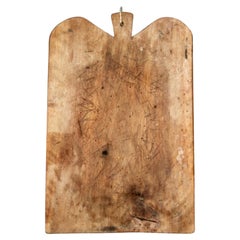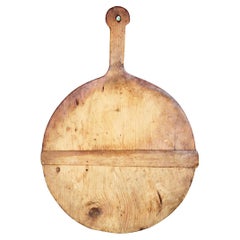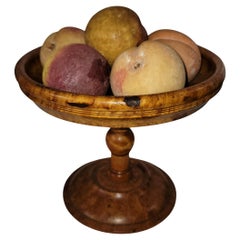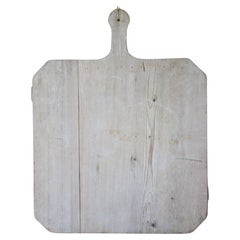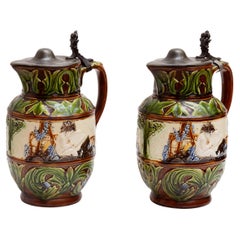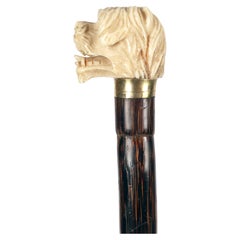Late 19th Century Antiquities
to
23
139
50
195
43
18
6
3
2
1
1
1
1
229
402
867
16
216
169
84
25
19
27
33
31
40
24
32
29
9
132
90
47
31
21
136
83
40
38
15
195
195
195
3
1
1
1
1
Period: Late 19th Century
19th Century French Bread Board
Located in grand Lancy, CH
19th Century French Bread Board
Category
Swiss Antique Late 19th Century Antiquities
Materials
Wood
19th Century French Bread Board
Located in grand Lancy, CH
19th Century French Bread Board
Category
French Antique Late 19th Century Antiquities
Materials
Wood
19thc Bird’S-Eye Maple Compote with Stone Fruit
Located in Los Angeles, CA
Each Fruit measures between 2.5 and 3 inches spherically. There is a collection of seven alabaster hand painted peaches and is in a burl or bird...
Category
American Adirondack Antique Late 19th Century Antiquities
Materials
Stone
$1,295 / set
19th Century French Bread Board
Located in grand Lancy, CH
19th Century French Bread Board
Category
Swiss Antique Late 19th Century Antiquities
Materials
Wood
Set of Two Majolica Jugs, Nimy Faiences Imperiale Belgium
Located in Antwerp, BE
A set of 1851-1898 Belgium majolica pitchers, pottery jugs with pewter top.White hand painted cherubs sitting in a painting impression and accesso...
Category
French Art Nouveau Antique Late 19th Century Antiquities
Materials
Ceramic, Majolica
$311 Sale Price / item
70% Off
Ivory handle walking stick depicting a dog’s head, England 1890.
Located in Milan, IT
Walking stick: carved ivory knob depicting a dog's head with an open mouth. Eyes in glass paste. Brass ring. Bamboo wood shaft. Brass ferrule. England circa 1890.
(SHIP ONLY IN EU)
Category
English Antique Late 19th Century Antiquities
Materials
Brass
19th Century French Bread Board
Located in grand Lancy, CH
19th Century French Bread Board
Category
French Antique Late 19th Century Antiquities
Materials
Wood
Pair Of Antique Boule Balls "G", Pétanque, 1880s, France, Craftsmanship
Located in Greven, DE
Beautiful, unique Boule ball pair, France, late 19th Century.
In the 19th century, the manufacture of boules balls underwent significant development in France as the game of boules,...
Category
French Late Victorian Antique Late 19th Century Antiquities
Materials
Olive
19th Century French Bread Board
Located in grand Lancy, CH
19th Century French Bread Board
Category
French Antique Late 19th Century Antiquities
Materials
Wood
19th C Iron Chicago Trains
Located in Los Angeles, CA
Pair of cast iron trains marked Chicago Rook Island & Pacific R. R. Good condition.
Category
American Adirondack Antique Late 19th Century Antiquities
Materials
Iron
$895 / set
Antique Boule Ball "J P", Pétanque, 1880s, France, Craftsmanship
Located in Greven, DE
Beautiful, unique Boule ball, France, late 19th Century.
In the 19th century, the manufacture of boules balls underwent significant development in France as the game of boules, part...
Category
French Late Victorian Antique Late 19th Century Antiquities
Materials
Metal, Brass
Antique Boule Balls Set "B", Pétanque, 1880s, France, Craftsmanship
Located in Greven, DE
Beautiful, unique Boule set of three Boule balls, France, late 19th Century.
In the 19th century, the manufacture of boules balls underwent significant development in France as the game of boules, particularly the pétanque variant, gained in popularity. The manufacture of boules balls during this period was a manual process that required expertise, precision and love to detail.
In the late 19th and early 20th centuries, particularly in rural areas of France and other Mediterranean regions, olive wood was a commonly used source of material for making boules balls. This was not only due to the availability of the material, but also to the outstanding properties of olive wood, which was characterized by hardness, strength and a rich grain.
First, the olive wood was carefully selected and shaped into raw balls, which were then sanded to the desired size and shape. The nails were then hammered into the balls one by one, making sure that they were evenly distributed and firmly anchored. Finally, the spheres were polished and coated with a protective varnish to enhance their natural beauty and protect them from the elements.
The use of nails to decorate and reinforce olive wood boules was a traditional practice that not only gave the ball a rustic aesthetic, but also improved its durability and contributed to customization. Many balls were made according to the specific requirements and preferences of the players. Nails were driven at regular intervals around the ball, with each nail hole precisely placed so as not to affect the balance and weight distribution of the ball. These nails not only served as a decorative element, but also helped to strengthen the structure of the ball and make it more resistant to the hard knocks and wear and tear during play. Individual engravings or decorations were often applied to the balls to make them unique and identify the player.
Antique boules...
Category
French Late Victorian Antique Late 19th Century Antiquities
Materials
Olive
Bent Wood Victorian Sled with Unique Form
Located in Vienna, Austria
A Victorian wooden sled, the type one often finds on vintage European Christmas cards. Designed for a child, it can be pushed or pulled.
You can al...
Category
Austrian Victorian Antique Late 19th Century Antiquities
Materials
Bentwood
$754 Sale Price
20% Off
1800s Norwegian folk art Box, Hand-carved by Ole Olsen Moene (1839-1908)
Located in Skien, NO
Exceptional 19th Century Norwegian Folk Art Tobacco Box by Ole Olsen Moene - Museum Quality
This remarkable 19th-century Norwegian folk art tobacco box, dating from the late 1800s, ...
Category
Norwegian Folk Art Antique Late 19th Century Antiquities
Materials
Birch, Nutwood, Beech, Bentwood
Swedish Birch hook 1886
Located in Farsta, SE
A large pine hook made in 1886 in Sweden is a historical tool used for various purposes. Pine or birch hooks, often made from a sturdy piece of wood, were commonly used in agricultur...
Category
Swedish Scandinavian Modern Antique Late 19th Century Antiquities
Materials
Birch
Antique Boule Ball "17", Pétanque, 1880s, France, Craftsmanship
Located in Greven, DE
Beautiful, unique Boule ball, France, late 19th Century.
In the 19th century, the manufacture of boules balls underwent significant development in France as the game of boules, part...
Category
French Late Victorian Antique Late 19th Century Antiquities
Materials
Metal
Antique Boule Ball "62", Pétanque, 1880s, France, Craftsmanship
Located in Greven, DE
Beautiful, unique Boule ball, France, late 19th Century.
In the 19th century, the manufacture of boules balls underwent significant development in France as the game of boules, part...
Category
French Late Victorian Antique Late 19th Century Antiquities
Materials
Metal
Silver walking stick with a rooster, France 1890.
Located in Milan, IT
Walking stick: silver handle depicting a rooster. Ebony shaft. Metal tip. France 1890 ca.
Category
French Antique Late 19th Century Antiquities
Materials
Metal, Silver
Ivory handle walking stick depicts the head of a monk, England 1880.
Located in Milan, IT
Walking stick: ivory knob. The handle depicts the head of a laughing monk. Bamboo wood cane, with silver eyelets for the through hole of the lace. Silver ring band. England circa 188...
Category
English Antique Late 19th Century Antiquities
Materials
Silver
Antique Handcrafted and Stable Solid Oak & Great Patina Joint Stool Or Table
Located in Lisse, NL
Solid oak joint stool, great shape and beautiful color.
This handcrafted joint stool seat is both rustic and stylish. It is an absolute joy to watch and to sit on. It is as stabile ...
Category
European Renaissance Revival Antique Late 19th Century Antiquities
Materials
Oak
Antique Boule Ball With Flower Decor, Pétanque, 1880s, France, Craftsmanship
Located in Greven, DE
Beautiful, unique Boule ball, France, late 19th Century.
In the 19th century, the manufacture of boules balls underwent significant development in France as the game of boules, part...
Category
French Late Victorian Antique Late 19th Century Antiquities
Materials
Metal, Brass
Antique "Latin-Français" Lexicon by Emile Chatelain – 1890 - 3Y20
Located in Bordeaux, FR
This rare 19th-century Latin-Français lexicon by Emile Chatelain, published in 1890 by Hachette et Compagnie in Paris, offers a valuable linguistic reference for scholars and collect...
Category
Antique Late 19th Century Antiquities
Materials
Paper
Historical Austrian Alps Goatbells, circa 1900
Located in Vienna, AT
In this ad you get the chance to buy a really rare antique. The object for sale is a bundle of historic goatbells used in Austria and Southern Germany on goats and small live stock w...
Category
Austrian Antique Late 19th Century Antiquities
Materials
Bronze
19th Century Eagle Painted Cast Iron Nut Cracker
Located in Stamford, CT
American 19th century eagle nut cracker. Cast iron with original painted finish.
Category
American Empire Antique Late 19th Century Antiquities
Materials
Iron
Silver handle walking stick, China for the Western market, 1890.
Located in Milan, IT
Walking stick with light rattan wood barrel and embellished handle. The handle, in 800/1000 silver, is a milord at the top of which there is a cushion element. The entire band is dec...
Category
Chinese Antique Late 19th Century Antiquities
Materials
Silver, Brass
Walking stick, silver handle depicting an elephant head, Germany 1890.
Located in Milan, IT
Walking stick: silver and bone knob, which depicts at its end an elephant head with rolled trunk in pure Art Nouveau style. Bone fangs and sulfur glass eyes. Wooden barrel painted bl...
Category
German Antique Late 19th Century Antiquities
Materials
Silver
Antique Boule Set, Boule Balls, Pétanque, 1880s, France, Craftsmanship
Located in Greven, DE
Beautiful, unique Boule set of two Boule balls and one target ball, France, late 19th century.
In the 19th century, the manufacture of boule balls underwent significant development ...
Category
French Late Victorian Antique Late 19th Century Antiquities
Materials
Olive
Antique Boule Ball "G", "J", Pétanque, 1880s, France, Craftsmanship
Located in Greven, DE
Beautiful, unique Boule ball, France, late 19th Century.
Decorated with the initials "G" and "J".
In the 19th century, the manufacture of boules balls underwent significant developm...
Category
French Late Victorian Antique Late 19th Century Antiquities
Materials
Olive
Pair Of Antique Boule Balls Circle, Pétanque, 1880s, France, Craftsmanship
Located in Greven, DE
Beautiful, unique Boule ball pair and one target ball, France, late 19th Century.
In the 19th century, the manufacture of boules balls underwent significant development in France as...
Category
French Late Victorian Antique Late 19th Century Antiquities
Materials
Olive
Walking stick ivory knob with pug dog head, Germany 1890.
Located in Milan, IT
Walking stick: carved ivory knob depicting the head of a pug dog. Glass paste eyes. Band in 800/1000 silver, with oak leaves in relief. Bamboo wood cane. Metal ferrule. Germany circa...
Category
German Antique Late 19th Century Antiquities
Materials
Ivory, Glass, Wood
Silver gilt handle walking stick depicting an hunting scene, Germany 1890.
Located in Milan, IT
Walking stick: handle, made out of silver gilt representing an hunting scene, with hunter and dogs. Ebony wood shaft. Metal ferrule. Germany circa 1890.
Category
German Antique Late 19th Century Antiquities
Materials
Metal, Silver
Ivory handle walking stick depicting a mangoose with a snake, France 1880.
Located in Milan, IT
Walking stick, carved ivory knob, depicting a mongoose with a snake in its mouth. Emerald and ruby eyes. 18K gold band. The barrel is sculpted and carved from a single patinated mapl...
Category
French Antique Late 19th Century Antiquities
Materials
Gold, Brass, Iron
Antique Boule Ball "P A", Pétanque, 1880s, France, Craftsmanship
Located in Greven, DE
Beautiful, unique Boule ball, France, late 19th Century.
In the 19th century, the manufacture of boules balls underwent significant development in France as the game of boules, part...
Category
French Late Victorian Antique Late 19th Century Antiquities
Materials
Metal
System walking stick, matches holder, Italy 1880.
Located in Milan, IT
System walking stick with deer horn tip, santos wood shaft (Cesalpina Ferrea, Brazil). L-shaped handle in slightly silvered brass with smooth band...
Category
Italian Antique Late 19th Century Antiquities
Materials
Brass
Antique Boule Ball "G", Pétanque, 1880s, France, Craftsmanship
Located in Greven, DE
Beautiful, unique Boule ball, France, late 19th Century.
In the 19th century, the manufacture of boules balls underwent significant development in France as the game of boules, particularly the pétanque variant, gained in popularity. The manufacture of boules balls during this period was a manual process that required expertise, precision and love to detail.
In the late 19th and early 20th centuries, particularly in rural areas of France and other Mediterranean regions, olive wood was a commonly used source of material for making boules balls. This was not only due to the availability of the material, but also to the outstanding properties of olive wood, which was characterized by hardness, strength and a rich grain.
First, the olive wood was carefully selected and shaped into raw balls, which were then sanded to the desired size and shape. The nails were then hammered into the balls one by one, making sure that they were evenly distributed and firmly anchored. Finally, the spheres were polished and coated with a protective varnish to enhance their natural beauty and protect them from the elements.
The use of nails to decorate and reinforce olive wood boules was a traditional practice that not only gave the ball a rustic aesthetic, but also improved its durability and contributed to customization. Many balls were made according to the specific requirements and preferences of the players. Nails were driven at regular intervals around the ball, with each nail hole precisely placed so as not to affect the balance and weight distribution of the ball. These nails not only served as a decorative element, but also helped to strengthen the structure of the ball and make it more resistant to the hard knocks and wear and tear during play. Individual engravings or decorations were often applied to the balls to make them unique and identify the player.
Antique boules...
Category
French Late Victorian Antique Late 19th Century Antiquities
Materials
Metal
Antique Boule Ball With Star Decor And C, Pétanque, 1880s, France, Craftsmanship
Located in Greven, DE
Beautiful, unique Boule ball, France, late 19th Century.
In the 19th century, the manufacture of boules balls underwent significant development in France as the game of boules, part...
Category
French Late Victorian Antique Late 19th Century Antiquities
Materials
Metal, Brass
Antique Boule Ball, Pétanque, 1880s, France, Craftsmanship
Located in Greven, DE
Beautiful, unique Boule ball, France, late 19th Century.
In the 19th century, the manufacture of boules balls underwent significant development in France as the game of boules, part...
Category
French Late Victorian Antique Late 19th Century Antiquities
Materials
Metal
Pair Of Antique Boule Balls, Pétanque, 1880s, France, Craftsmanship
Located in Greven, DE
Beautiful, unique Boule ball pair and one target ball, France, late 19th Century.
In the 19th century, the manufacture of boules balls underwent significant development in France as...
Category
French Late Victorian Antique Late 19th Century Antiquities
Materials
Metal
Collection of Twelve Antique Miniatures Sad Iron/Flat Cast Iron
Located in Guaynabo, PR
This is a collection of twelve antique miniatures sad irons/flat cast irons. Some of them are identified by numbers ( 0, 1 and 2). Another ones are hallmark...
Category
American American Craftsman Antique Late 19th Century Antiquities
Materials
Iron
$316 Sale Price / set
20% Off
Antique carpet beater, heart-shape, United Kingdom, late 1800s.
Located in Milan, IT
Antique carpet beater, to remove dust from carpets, heart-shaped in heavy twisted metal wire, with double connection (from and) through the mesh to obtai...
Category
British Antique Late 19th Century Antiquities
Materials
Metal
Folk art carved walking stick depicting a German Shepherd dog, Austria 1890.
Located in Milan, IT
Folk art walking stick: carved wooden handle depicting a German Shepherd dog’s head, sulphur glass eyes. Hawthorn wood shaft and metal ferrule. Silver gilt ring. Austria circa 1890.
Category
Austrian Antique Late 19th Century Antiquities
Materials
Metal, Silver
Provincial Chinese Trunk Mortar, c. 1900
Located in Chicago, IL
This large wooden mortar dates to the late 19th century and was originally used for crushing rice, grain, spices and other foodstuffs. Carved from a single tree trunk, the mortar has...
Category
Chinese Organic Modern Antique Late 19th Century Antiquities
Materials
Wood
Pair Of Antique Boule Balls, Pétanque, 1880s, France, Craftsmanship
Located in Greven, DE
Beautiful, unique Boule ball pair, France, late 19th Century.
Diameter 9,5 cm.
In the 19th century, the manufacture of boules balls underwent significant development in France as the game of boules, particularly the pétanque variant, gained in popularity. The manufacture of boules balls during this period was a manual process that required expertise, precision and love to detail.
In the late 19th and early 20th centuries, particularly in rural areas of France and other Mediterranean regions, olive wood was a commonly used source of material for making boules balls. This was not only due to the availability of the material, but also to the outstanding properties of olive wood, which was characterized by hardness, strength and a rich grain.
First, the olive wood was carefully selected and shaped into raw balls, which were then sanded to the desired size and shape. The nails were then hammered into the balls one by one, making sure that they were evenly distributed and firmly anchored. Finally, the spheres were polished and coated with a protective varnish to enhance their natural beauty and protect them from the elements.
The use of nails to decorate and reinforce olive wood boules was a traditional practice that not only gave the ball a rustic aesthetic, but also improved its durability and contributed to customization. Many balls were made according to the specific requirements and preferences of the players. Nails were driven at regular intervals around the ball, with each nail hole precisely placed so as not to affect the balance and weight distribution of the ball. These nails not only served as a decorative element, but also helped to strengthen the structure of the ball and make it more resistant to the hard knocks and wear and tear during play. Individual engravings or decorations were often applied to the balls to make them unique and identify the player.
Antique boules...
Category
French Late Victorian Antique Late 19th Century Antiquities
Materials
Olive
Pair Of Antique Boule Balls "24", Pétanque, 1880s, France, Craftsmanship
Located in Greven, DE
Beautiful, unique Boule ball pair and one target ball, France, late 19th Century.
In the 19th century, the manufacture of boules balls underwent significant development in France as...
Category
French Late Victorian Antique Late 19th Century Antiquities
Materials
Olive
Antique Wabi Sabi Wooden Root Bowl, Bulgaria c. late 1800s
Located in Hønefoss, 30
A wonderfil antique wabi sabi wooden root bowl with beautiful patina from age and use.
Category
Bulgarian Romantic Antique Late 19th Century Antiquities
Materials
Wood
Bird Cage
Located in Hellerup, DK
Antique French unique handmade, carved and painted dolls house-like birdcage - oversized and with many unique details which makes it look more like a birds-chateau and is very far fr...
Category
French Antique Late 19th Century Antiquities
Materials
Metallic Thread
$2,314 Sale Price
24% Off
Folk art walking stick depicting the grottesque head of a man, France 1880.
Located in Milan, IT
Folk art walking stick: single cork wood branch. The handle of the stick, a carved corozo nut representing the head of a grotesque man with an oblong face with an open mouth and glas...
Category
French Antique Late 19th Century Antiquities
Materials
Iron
19th Century Walla Walla Prison Horse Bit Collection
Located in Coeur d'Alene, ID
Collection of seven Walla Walla prison made bits. All silver overlaid but unique from each other with various techniques and designs. In the 19th Century f...
Category
American Antique Late 19th Century Antiquities
Materials
Hide, Leather
Late 19th Century English Lawn Tape by Chesterman, Sheffield
Located in Chapel Hill, NC
Late 19th century lawn tape by Chesterman, Sheffield, England. Chesterman's patented steel tape in leather case. 200 ft tape. Leather hand strap; brass fittings. See The Smithsonian ...
Category
English Antique Late 19th Century Antiquities
Materials
Brass, Steel
A Carved Alpine Oxen Yoke - French Alps - XIXth century.
Located in SOTTEVILLE-LÈS-ROUEN, FR
A huge carved oxen yoke, dating back to the 19th century, is a beautiful example of Alpine folk craftsmanship. Its intricate carvings and rustic charm make it a truly captivating dec...
Category
French French Provincial Antique Late 19th Century Antiquities
Materials
Wood
$518 Sale Price
20% Off
Antique carpet beater, guitar-shape, United Kingdom, late 1800s.
Located in Milan, IT
Antique carpet beater, to remove dust from carpets, in the shape of a guitar in heavy twisted metal wire woven into a honeycomb, to obtain greater resist...
Category
English Antique Late 19th Century Antiquities
Materials
Metal
Folk art carved walking stick depicting a German Shepherd dog, Germany 1890.
Located in Milan, IT
Folk art walking stick: carved wooden handle depicting a German Shepherd dog’s head, sulphur glass eyes, bone teeth. Hawthorn wood shaft and metal ferrule. Silver gilt ring. Germany ...
Category
German Antique Late 19th Century Antiquities
Materials
Metal
Woman's Footwear with Bandaged Feet China Circa 1900
Located in Beuzevillette, FR
Woman's shoe with bandaged feet, in embroidered satin.
The custom of bandaged feet is said to have appeared in China in the 10th century during the Tang Dynasty, when the emperor as...
Category
Chinese Chinoiserie Antique Late 19th Century Antiquities
Materials
Satin
Antique Chocolate Molds, c.1890 - set of 4
Located in Savannah, GA
A set of four highly detailed cast iron chocolate molds, circa 1890
rooster: 5 inches wide by 3 inches deep by 5 ½ inches tall
rabbit and swan: 4 ½ inches wide 2 ¼ inches deep by 3 ...
Category
Antique Late 19th Century Antiquities
Materials
Iron
$1,200 / set
Antique Green Glass Carboy with Wicker Cover
By NONO
Located in Guadalajra, Jal
Antique Green Glass Carboy with Wicker Cover
Carboys were often protected from shocks and temperature changes by being placed in wicker covers. Very well-...
Category
Mexican Folk Art Antique Late 19th Century Antiquities
Materials
Wicker, Blown Glass
19th Century English Quirky Country House Fire Escape
Located in London, GB
19th century English country house fire escape
We are proud to offer a rare example of a 19th century quirky county house fire escape, once of the Fasque House, Fettercaine Estate, ...
Category
British Early Victorian Antique Late 19th Century Antiquities
Materials
Wood
19th Century French Bread Board
Located in grand Lancy, CH
19th Century French Bread Board
Category
French Antique Late 19th Century Antiquities
Materials
Wood
19th Century French Bread Board
Located in grand Lancy, CH
19th Century French Bread Board
Category
French Antique Late 19th Century Antiquities
Materials
Wood
19th Century French Bread Board
Located in grand Lancy, CH
19th Century French Bread Board
Category
French Antique Late 19th Century Antiquities
Materials
Wood
Victorian Travel Grooming Kit, c. 1900
Located in Chicago, IL
This charming antique box dates to the late 19th century and is a Victorian-era travel kit with sewing and grooming tools, also known as an etui or nécessaire. The compact travel cas...
Category
American Victorian Antique Late 19th Century Antiquities
Materials
Metal
Recently Viewed
View AllMore Ways To Browse
French Lingerie Chest
French Terra Cotta Statues
French Vaisselier
Gear Wheel
George 1 Chest Of Drawers
Giacometti Style Statues
Ginbari Vase
Gold Screen Crane
Grand Tour Neoclassic Statues
Greek Krater
Green Glass Elephant
Green Wedgwood Vase
Haddon Hall Furniture
Hand Blown Glass Horses
Haring Pottery
Henredon Walnut Chest
Meeks Furniture
Porcelain Elephants
